|
Tan Son Nhut AB, 377th SPS, by David Dowdell |
|
RAAF No.9SQ Veterans
marching down the streets of Tamworth New South Wales
|
|
The year was 1968. I was a member of the 377th SPS, stationed at Tan Son Nhut Air Base, Republic of Vietnam. Our squadron was still pulling extended duty and reserve QRT's were still being deployed along the base perimeter. The sounds of incoming mortar and rocket fire seemed to be a nightly occurrence. I had just returned to full duty on Charlie Flight/Charlie Sector, after being assigned to CSC and riding on an Army EOD Team, in a light duty capacity. I had received minor shrapnel wounds from a 122mm rocket attack back on 18 February 68, when I was posted on the north revetment aircraft parking area. MSgt Garcia, the NCOIC in Charlie Sector, advised me that I had been selected for transfer to Detachment 1/377th SPS, at Vũng Tàu Air Field. The TDY orders were for a ninety-day assignment at the so-called in country R&R center, so I had no problem with the transfer. |
|
A current RAAF Airman chats with No. 9SQ Vietnam veterans before their formation in downtown Tamworth, New South Wales . 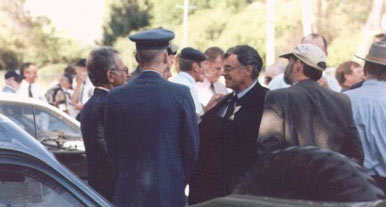 Detachment 1 was assigned to the Royal Australian Air Force's Air Base Defense Group. This combined unit's mission was to provide typical Air Base defense protection. The ADG's and SP's pulled entry control and fixed bunker/tower posts, as well as mobile strike team response. Vũng Tàu Air Field supported a wide variety of military units from various branches of service and country's of origin. The RAAF's 9 Squadron Attack Helicopter Unit and the U.S. Navy's Seawolves Attack Helicopter Squadron proved to be a significant presence at the airfield. The RAAF also had a number of C-7 fixed wing aircraft at the airfield. The limitations of the airfield precluded many large aircraft from landing at or taking off from the airfield. I seem to recall that only C-123 and C-130 transports were the only transient aircraft that used Vũng Tàu Air Field on a regular basis. |
|
9SQ veterans seem to come
from all walks of life. This is one of the |
|
In June 1966, the RAAF's 9 Squadron's eight UH-1B helicopters and a small maintenance party sailed for Vietnam in the HMAS Sydney. They anchored off Vũng Tàu on June 12, 1966, and the Huey Iroquois were flown off the ship to Vũng Tàu Air Field, the Squadron's new home. The remainder of the Squadron flew to Vietnam in a Qantas aircraft. |
|
Operations began the very next day
when the Squadron received an urgent request for the 5th Royal Australian
Regiment (5RAR) for a resupply of ammunition. While it was not expected
that operations would begin so quickly, the ammo resupply mission was
accepted. This first mission was to mark the beginning of six years of
combat flying for the 9th Squadron. |
|
Throughout its participation, Australia relied
heavily on U.S. logistical support and as a result only a small percentage
of its troops engaged in support services. In contrast to the U.S., Australia
rotated entire regiments, rather than individuals, into and out of Viet
Nam, but like the U.S., it conscripted soldiers to fill its ranks. |
|
The RAAF flag ceremony
that concluded the wreath laying
In 1998, I began an effort to locate my old Aussie buddies from Vung
Tau. It was a formidable task to say the least! Trying to locate them
after thirty years, with the Pacific Ocean between us, made contact unlikely.
Well, through the miracle of the internet, I found a few Australian web
sites that were dedicated to their Vietnam Veterans organizations. I
began to sign their guestbooks and left information on my unit's assignment
at Vũng Tàu with my dates of service at the airfield. |
|
The eulogy and benediction at the Tamworth Memorial. 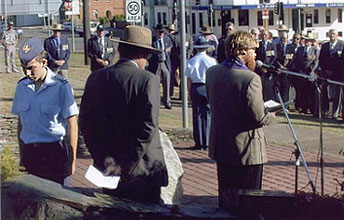 I received e-mails from a few Aussie vets who were stationed in Vietnam
after I rotated back, as well as messages from spouses of ANZAC Vietnam
veterans. They provided me with leads on contacting some of these guys.
Success was achieved when I received an e-mail from Neil Tyne. Neil was
also known as 'Tiny', when he was a member of the ADG Squadron, at Vung
Tau Air Field. Neil was living in Tazmania. He was retired from a career
as a Supervising Governor at a prison facility and recalled many of the
377th SPS who were stationed at Vũng Tàu, in 1968. He provided me with the
internet address of Alan Brazil, who was another ADG Squadron member I'd
been attempting to locate. Alan was living on the mainland in the Newcastle,
NSW area, and had also retired as a civil servant from the Australian prison
system.
I received e-mails from a few Aussie vets who were stationed in Vietnam
after I rotated back, as well as messages from spouses of ANZAC Vietnam
veterans. They provided me with leads on contacting some of these guys.
Success was achieved when I received an e-mail from Neil Tyne. Neil was
also known as 'Tiny', when he was a member of the ADG Squadron, at Vung
Tau Air Field. Neil was living in Tazmania. He was retired from a career
as a Supervising Governor at a prison facility and recalled many of the
377th SPS who were stationed at Vũng Tàu, in 1968. He provided me with the
internet address of Alan Brazil, who was another ADG Squadron member I'd
been attempting to locate. Alan was living on the mainland in the Newcastle,
NSW area, and had also retired as a civil servant from the Australian prison
system.My e-mail files were quickly filling with contacts from many RAAF 9 SQ members who I didn't serve time with at Vung Tau Air Field. I began making new friends who shared one common link with me as a Vietnam veteran. These contacts continued for many months. In October 2000, I received an invitation to attend their RAAF 9 SQ Vietnam Veteran's Reunion, to be held in Tamworth, NSW, on February 23rd thru 25th, 2001. My wife and I took this opportunity to travel 'down-under' and renew old friendships with my 'Australian mates'. The 9 SQ Reunion was two years in the making. Squadron members from all points had committed to attend the reunion. Tamworth, New South Wales is the so-called 'Country Music Capital' of Australia. It is located about six hours-by-car from the coastal city of Brisbane. The challenge for us was the long and arduous flight from Central Ohio to the East Coast of Australia. It took us twenty-nine hours to travel from home to the Brisbane International Airport. Of that twenty-nine hours we were in the air for over twenty-two hours. We flew from Columbus to Houston, Houston to Honolulu, Honolulu to Guam, and Guam to Cairns, Queensland, in the Gold Coast Area of Australia. |
|
Sergeant Peter Amos, a former RAAF No.9SQ Vietnam veteran, stand in a moment of silence for fallen comrades ... Lest We Forget their only utterance . 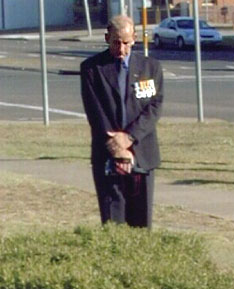 We took a domestic Qantas flight, from Cairns to Brisbane, and were picked up by Don Paul, an RAAF 9SQ Vietnam veteran, for the six-hour drive to Tamworth, NSW. Donnie was a side door gunner on a UH-1B Iroquois gunship helicopter and was stationed at Vung Tau Air Field, in 1970-1971. We had never met before, but became friends during our drive to Tamworth. I had been warned in an e-mail, before our flight to Australia, "the drinking would commence…once we arrived in Tamworth", and they were correct. The first evening's activities were held at the Returning Servicemen's Club (RSL Club), in Tamworth. Their RSL Clubs are similar to our VFW Clubs in America. I met my sponsor, Peter Amos, at the RSL Club. Peter also helped us arrange our trip to Australia. He was a crew chief on a UH-1B Iroquois out of Vũng Tàu during the time I was stationed there. I was quickly reintroduced to Victoria Bitter beer. I immediately realized that the Aussie's still drank like they did over thirty-three years ago….the only problem was that I didn't! The following morning, the entire reunion party met for a business meeting and social hour. 9SQ Officers conducted an audio visual history of their unit and had a variety of displays in the meeting room. In the evening, all 9SQ veterans mustered into formation wearing their awards and citations. The RAAF Marching Band and an array of vintage military vehicles added to the formation, which marched through the downtown streets of Tamworth. A wreath laying ceremony was conducted at the Tamworth City Memorial with much emotion and formality. Vehicles and pedestrians stopped to watch the ceremony and also honored those who didn't return. "Lest We Forget" was recited during the roll call of those RAAF 9SQ members who gave the ultimate sacrifice. The formation proceeded to the RSL Club for an evening a drinking, dining, and dancing. Friendships were renewed, photos were shared with one another; stories, both traumatic and comical were recanted amongst 9SQ veterans. A good time was had by all! One story of heroism evolved around the actions of Flight Lieutenant Garry Cooper, who flew an OV-1 spotter airplane in III Corps. His efforts to save a downed pilot resulted in being the only Australian ever considered for the Congressional Medal of Honor. One from the lighter side of the war, involved a 9SQ Huey pilot who was flying a gunship mission north of Vũng Tàu Air Field. The pilot saw a U.S. Army low-boy, flat bed truck, running light back towards Vũng Tàu. This type of truck hauls armored vehicles and has an extended flat bed capacity for either an M113 APC or an M-48 medium sized battle tank. The pilot maneuvered his Huey gunship down towards the vehicle. The unsuspecting U.S. Army truck driver was unaware of the chopper's presence above his rig. Laughter erupted when 9SQ veterans recanted when the Huey pilot actually landed his gunship on the flat bed trailer…as the truck was rambling down Highway 2…and seeing the startled look on the driver's face as he glanced in his rear view mirror. "The Yanks eyes were as big as silver dollars when he saw the Huey, sitting on the flat bed under full power, in his rear view mirror", said the crew chief from that flight crew. |
|
Dave and Bev Dowdell attending the RAAF
No.9SQ Vietnam
David Dowdell |
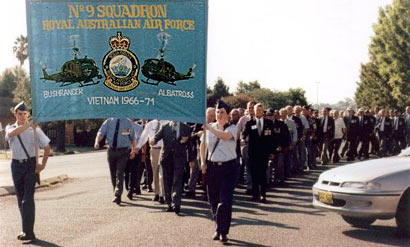 Reunion
Australia!
Reunion
Australia!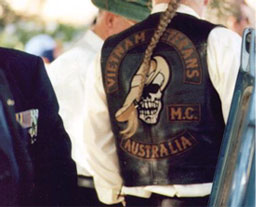 It didn't take me long to experience
what it would be like to be posted with the RAAF ADG-ER's. They were a
unique group of individuals…to say the least…and humping the
flight line, or pulling bunker and mobile Golf units with them was an
experience I will never forget!
It didn't take me long to experience
what it would be like to be posted with the RAAF ADG-ER's. They were a
unique group of individuals…to say the least…and humping the
flight line, or pulling bunker and mobile Golf units with them was an
experience I will never forget!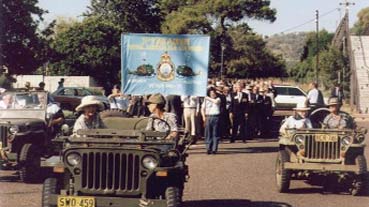 RAAF
No. 9SQ members forming up for
RAAF
No. 9SQ members forming up for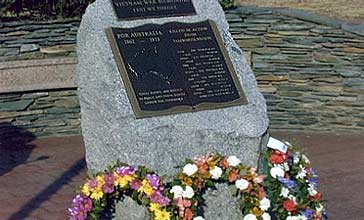
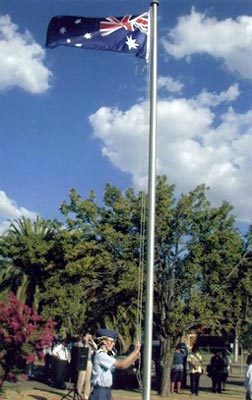 Australian and New Zealand forces left Vietnam in 1971. Only a small
contingent of Australian Army Assistance Group (AAAG) personnel remained
in Southeast Asia to continue to train South Vietnamese and Khmer Republic
Forces. They remained until January 1973.
Australian and New Zealand forces left Vietnam in 1971. Only a small
contingent of Australian Army Assistance Group (AAAG) personnel remained
in Southeast Asia to continue to train South Vietnamese and Khmer Republic
Forces. They remained until January 1973.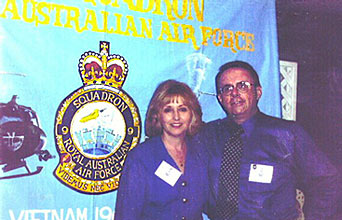 I came away from the 9SQ Reunion with
a commitment from the Aussie veterans to make a concerted effort to link
up old USAF personnel with ANZAC personnel, in an attempt to renew old
friendships. I know there are a lot of Vietnam Security Police Association
members who had similar contacts with Australian military personnel while
they were stationed in South Vietnam and Thailand. Whether it was at
Korat AFB, Phang Rang AFB, or Vũng Tàu Air Field, the VSPA and 9SQ/ADG
Associations need to compile their membership lists and internet addresses
so more of us can experience the joy of renewing old, old friendships.
I came away from the 9SQ Reunion with
a commitment from the Aussie veterans to make a concerted effort to link
up old USAF personnel with ANZAC personnel, in an attempt to renew old
friendships. I know there are a lot of Vietnam Security Police Association
members who had similar contacts with Australian military personnel while
they were stationed in South Vietnam and Thailand. Whether it was at
Korat AFB, Phang Rang AFB, or Vũng Tàu Air Field, the VSPA and 9SQ/ADG
Associations need to compile their membership lists and internet addresses
so more of us can experience the joy of renewing old, old friendships.